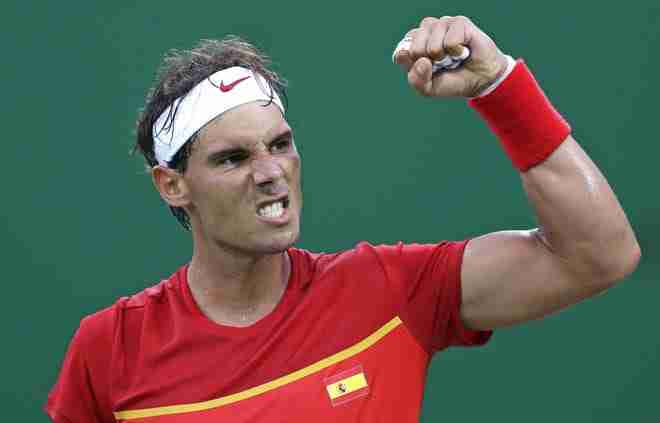
RIO DE JANEIRO (AP) — With a white ribbon peeking out from under the red bandage on his injured left wrist, Rafael Nadal was back in action Sunday, playing his first match in 2 1/2 months.
And he was back at the Olympics for the first time in eight years.
Nadal, however, insisted he was not back to full fitness after his 6-2, 6-1 win over Argentina’s Federico Delbonis at the Rio de Janeiro Games. And he also insisted he would not discuss the problematic tendon sheath in his racket-wielding arm for the remainder of the event.
“My wrist is not perfect. It needs more time,” the Spaniard said. “If this was a ‘normal’ tournament on the tour, I wouldn’t be here. My wrist is not perfect. It’s not 100%.”
Nadal won a singles gold medal at the 2008 Beijing Games, but missed the 2012 London Olympics with a knee injury that also forced him to withdraw from the US Open later that season.
“There is only one chance every four years to experience the Olympic Games. It is something unforgettable,” said Nadal, who carried the Spanish flag at the opening ceremony. “I missed the last Games in London, so I didn’t want to miss these.”
A former world No. 1 and 14-time Grand Slam champion, Nadal is one of the central figures in his sport. His health is therefore a big topic in tennis. It was also the biggest story on a windswept, star-studded second afternoon of competition in Brazil, which included straight-set victories by 2012 singles gold medallists Serena Williams and Andy Murray; world No. 1 Novak Djokovic was set to face Juan Martin del Potro in the evening.
Williams’ uneven 6-4, 6-2 defeat of Australia’s Daria Gavrilova in the main stadium saw winds of up to 40km/h cause delays of around two hours on the eight smaller courts. Murray beat Serbia’s Viktor Troicki 6-3, 6-2 in less than an hour and a half.
Neither Williams nor Murray had played since winning the Wimbledon titles a month ago, and both were in doubles action later Sunday alongside their older siblings: Williams with sister Venus; Murray with brother Jamie.
Sunday’s match was Nadal’s first since he surprisingly showed up at a news conference at Roland Garros with a blue splint on his left wrist and announced he would withdraw from the clay-court tournament he has won a record nine times.
A question about his wrist came early in the English portion of his post-match session with reporters Sunday, and when the Spanish portion opened with a question on the same topic, Nadal’s response began with a smile and the words: “I said it in English, and I’ll say it again in Spanish.”
He made it clear twice that he did not want to address the issue later in Rio.
Nadal looked a bit hesitant early in the match against Delbonis, another left-hander ranked 43rd, but ultimately showed confidence with his high-topspin forehand, producing half of his 14 winners with that shot.
On his way to the break to lead 3-2, Nadal hit a forehand winner down the line, then threw a powerful uppercut and shouted “Vamos” — prompting a resounding roar from the crowd. There was a nearly identical celebration and crowd reaction at the end of the match.
Nadal played cleanly, committing only 15 unforced errors, while Delbonis made 31.
In fact, the only thing that really bothered Nadal, the No. 3 seed, that day (aside from perhaps the wrist-spin questions) was the signage on the court behind the baselines. At one end is a scoreboard, at the other a serve-speed display, and it contains a few shades of green and yellow, which Nadal said made it difficult to see the yellow tennis balls during play.
He said the International Tennis Federation needed to ensure the setup was better because “you can’t play when you lose sight of the ball.”
ITF spokesman Nick Imison said tournament organisers would look into Nadal’s comments.
